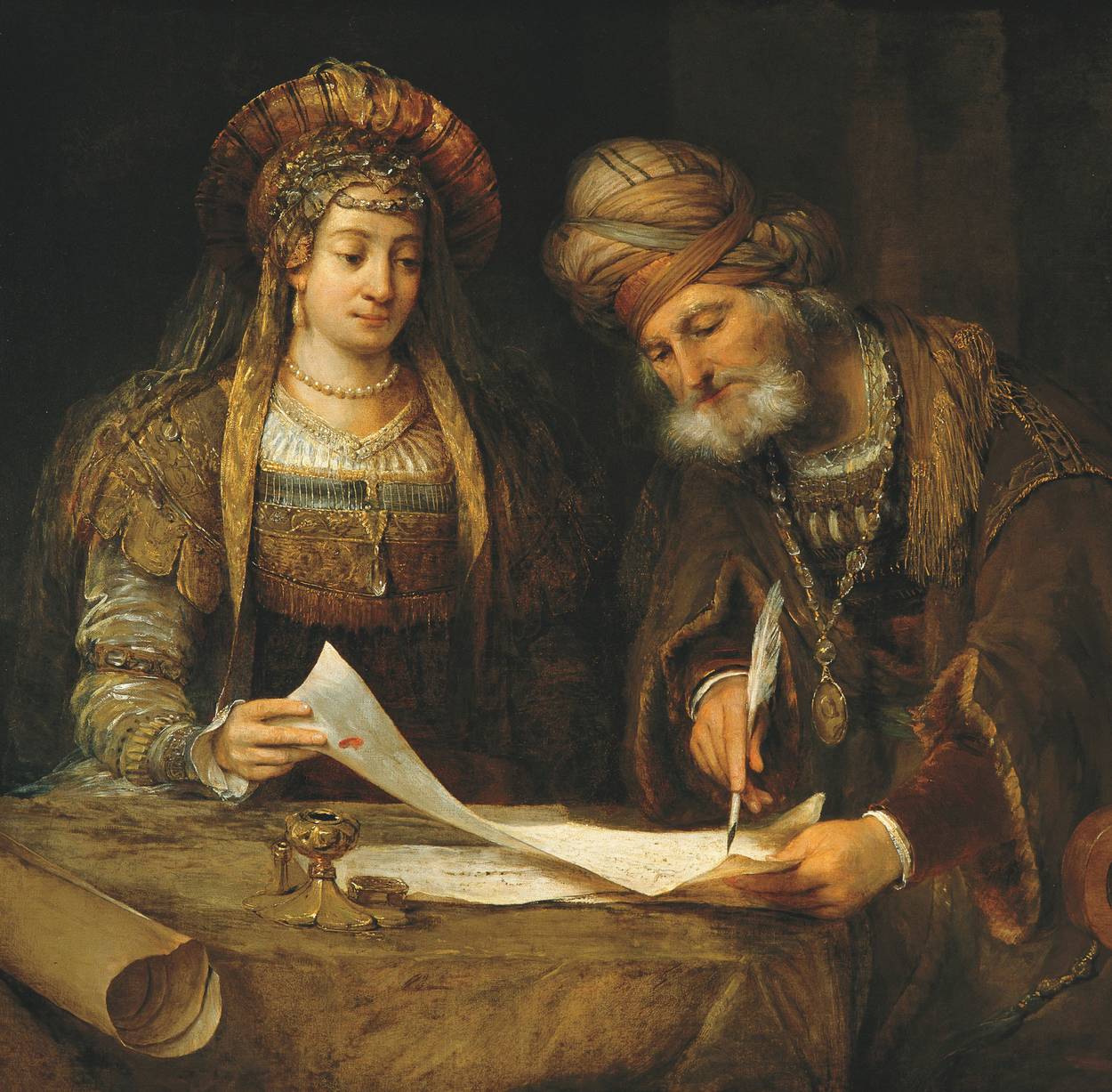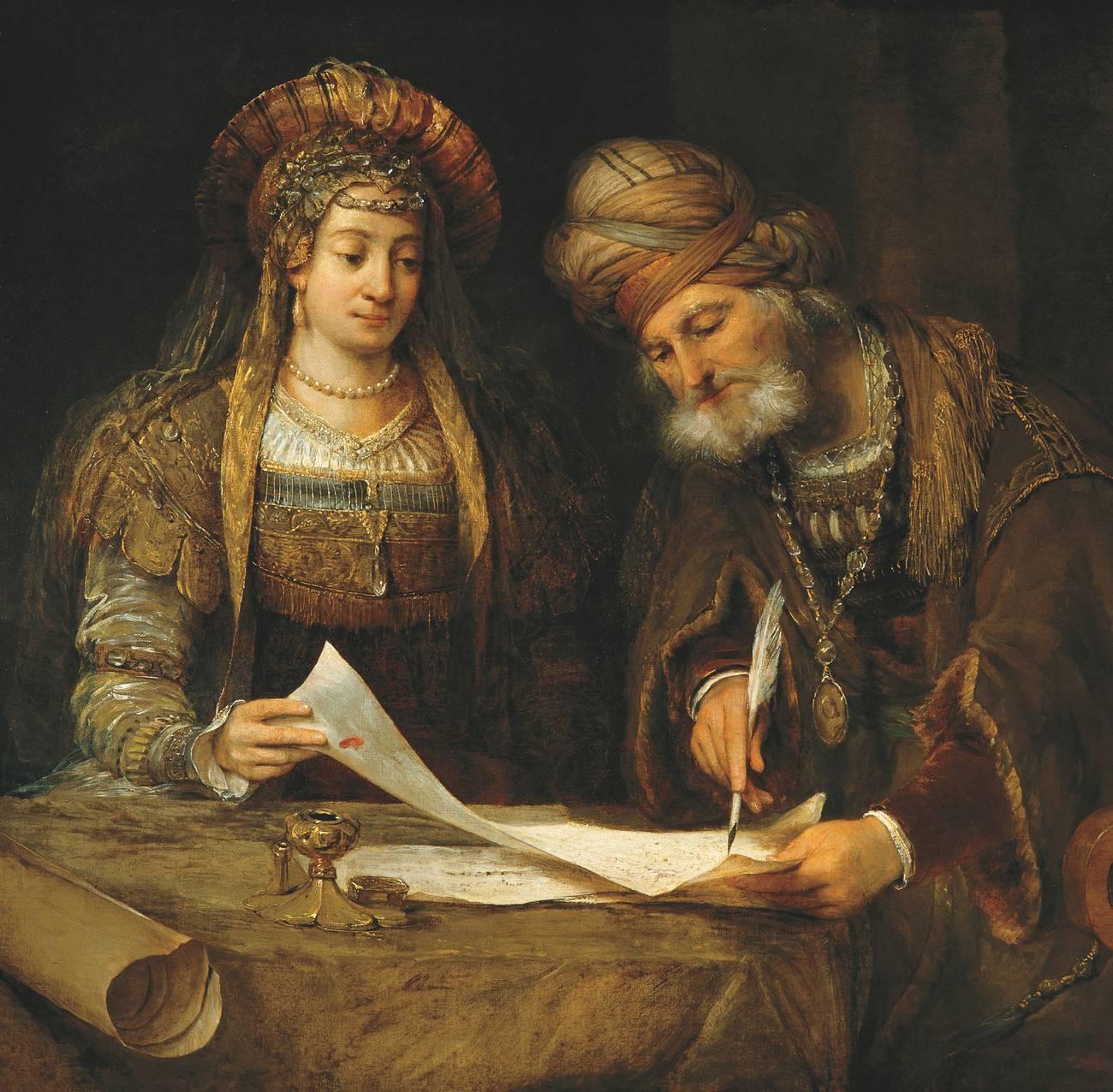The Other Side of Esther
The Hebrew version we read doesn’t mention God, and avoids theology. But the ancient Greek versions of the story took a very different approach.




The scroll of Esther is the Hebrew Bible’s least religious book. Nonreligious, even: It contains neither prophecy nor prayer; almost every other biblical book does. Absent as well is any theological system of reward and punishment. Its author does not even view as problematic Esther’s inevitable violations of Jewish dietary laws. By contrast, the Book of Daniel, another text set in the post-exilic period, begins its story by demonstrating the fealty to the laws of kashrut by Daniel and his three friends; they subsisted on legumes and water instead of consuming the rations and wine provided by King Nebuchadnezzar. And perhaps most problematic of all in the Book of Esther as we read it in Hebrew today, God is never mentioned. Serendipity seems to replace him as the chief architect of Israel’s destiny.
Various ancient Greek translations of Esther, however, are far more religious.
As in modern times, many diasporic Jews in the ancient world could barely read, let alone understand, Hebrew. Those living in places dominated by Hellenism—such as Alexandria in Egypt and the Greek isles—would gather in synagogues to read from sacred scripture translated into their Greek vernacular. The story of Esther that these communities heard on Purim vastly differs from the tale as told by our familiar Hebrew text.
The most popular version of the Greek Esther was composed sometime between Sept. 12 in 78 BCE and Sept. 11 in 77 BCE by Lysimachus, an Egyptian Jew living in Jerusalem about 400 years after the events recounted in the story of Purim. Like all translators, Lysimachus interprets his Hebrew source text while rendering it meaningful in Greek. Some of his changes are minor: He includes Haman in the first chapter as one of King Ahasuerus’ seven eunuchs (1:10); reduces the number of enemies that the Jews kill on the 13th of Adar from 75,000 to 15,000 (9:16); and explains that jealousy about Mordechai’s recent promotion prompted some eunuchs to devise a regicidal plot (2:21).
But Lysimachus also actively fixes perceived theological and religious problems with his Hebrew source text. After Haman determines to kill the Jews, Mordechai pleads with Esther (4:8): “Call upon the Lord, and speak to the king about us, and deliver us from death!” Likewise, it is the “Lord” who prevents Ahasuerus from falling asleep (6:1). And when Mordechai and the Jews instill fear among the nations (8:17), they “were circumcised and became Jews” (Greek text) instead of merely “professing to be Jews” (Hebrew).
Also at stake for Lysimachus was religious practice. Only in the Greek does Mordechai’s letter permit the Jews to defend themselves as well as “to live in accordance with their laws in every city” (8:11). And in its Hebrew version, Mordechai commands Esther to conceal her ancestry and Esther obeys, “just as when she was brought up by him.” In the Greek version, Mordechai commands Esther “to fear God and to do his ordinances, just as when she was with him. So Esther did not change her way of life” (2:20). Esther presumably kept some version of kosher.
The Greek Esther also contains six large passages absent from the Hebrew. Scholars call them Additions A through F. Addition B details the text of Haman’s edict to vanquish the Jews, and Addition E contains content of Mordechai’s decree to rescind it. They add further texture to a familiar tale. Additions C and D, located between Esther’s request that the Jews of Susa fast (4:17) and her audience with Ahasuerus (5:3), introduce religion into the narrative. Addition C describes the prayers with which Mordechai and Esther beseech God. And Addition D claims that Esther angered Ahasuerus when she approached him. That is, until God changed the king’s mood.
The remaining two Additions introduce and conclude the story as well as radically reframe it into a drama about prophecy and fulfillment. Addition A contains two parts. In the first, Mordechai receives a vision: Two dragons clash (yes, Jews also do dragons!), nations prepare for war against the righteous, and through prayer the lowly are exalted. In the second, Mordechai enters the king’s service by foiling a plot on the monarch’s life. But in turn, he earns the scorn of Haman, who was fond of the conspirators. In Addition F, Mordechai finally understands and explains the vision he received in Addition A. He also provides a new etymological origin for the word and holiday Purim (i.e., lots). The world exists as two lots: Israel and the Nations. When the time came for God to decide between to the two, he “remembered his people and vindicated his own inheritance.” The Addition concludes by telling us about Lysimachus.
Ultimately, the Greek Esther transforms a godless Hebrew narrative into a story of divine providence and redemption—a text worthy of the biblical canon. So why not follow the example of our Greek-speaking ancestors? How about we translate the Greek version and read it this Purim in place of our current Hebrew text?
Perhaps we really need the Hebraic Esther. Granted, this version of the story sidelines religious beliefs, precepts, and practices. But it is animated by something equally (if not more) fundamental: Jewish peoplehood and identity, the not-necessarily-religious glue that binds Jews together. Although Mordechai hails from the tribe of Benjamin, the narrative throughout calls him the “Jew” (yehudi). Esther ascends to the throne—and is almost deposed from it—by concealing her Jewish identity (2:19-20). And it is ultimately her self-revelation as a Jew that saves the day (7:4), not some preordained prophecy or belief-fueled deus ex machina. Haman, likewise, acts against the Jews as people. Although incensed by a personal affront, he seeks to eradicate all the Jews, “Mordechai’s nation” (3:6) who in his estimation commit treason “by not keeping the king’s laws” (3:8). Haman’s downfall, as well, is predicated on the fact that he acted against the Jews as a family. His wife, Zeresh, said it best: “If Mordechai, before whom your downfall has begun, is of the Jewish people (lit. from the seed [zerah] of the Jews [yehudim]), you will not prevail against him, but will surely fall before him” (6:13).
It is this version of the Esther story that best aids its modern readers in thinking about the current variant of the antisemitism that infects the minds of otherwise rational humans. Judaism’s contemporary detractors rarely challenge the validity of Moses’ laws; they can tolerate—and even laud—Judaism as a religious system constituted by a series of otherworldly beliefs and ritual practices. What they cannot brook is the Jewish spirit, Judaism as an identity constituted by a cohesive family in which each member cares about and feels deeply for one another, “one nation spread out among the nations” (3:8). Consequently, they fail to fathom why many Jews view as facile any boundary that segregates antisemitism from anti-Zionism. They cannot comprehend Judaism’s long history that includes thousands of years of being oppressed for being identified as a Jew. And they cannot acknowledge the vast geographic and ethnic diversity within the Jewish nation, that the skin tone of the modern Jew ranges well beyond various shades of white. Ultimately, the modern Haman wishes to whittle away at Judaism until all that remains is a religious husk devoid of the animating force provided by the particularistic identity of peoplehood. But Jews know better. And the Hebrew Esther is their story.
A.J. Berkovitz is a historian of ancient Jews and Judaism. His first book is A Life of Psalms in Jewish Late Antiquity, which received a Jordan Schnitzer first book publication award from the Association for Jewish Studies. He currently teaches at HUC-JIR/NY.